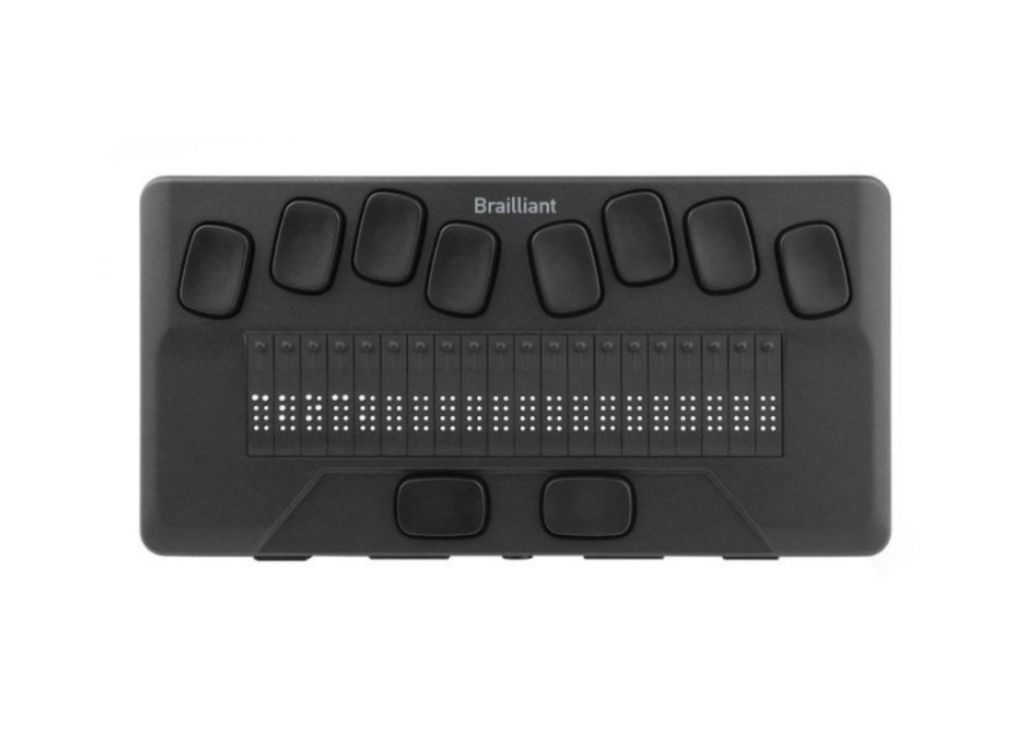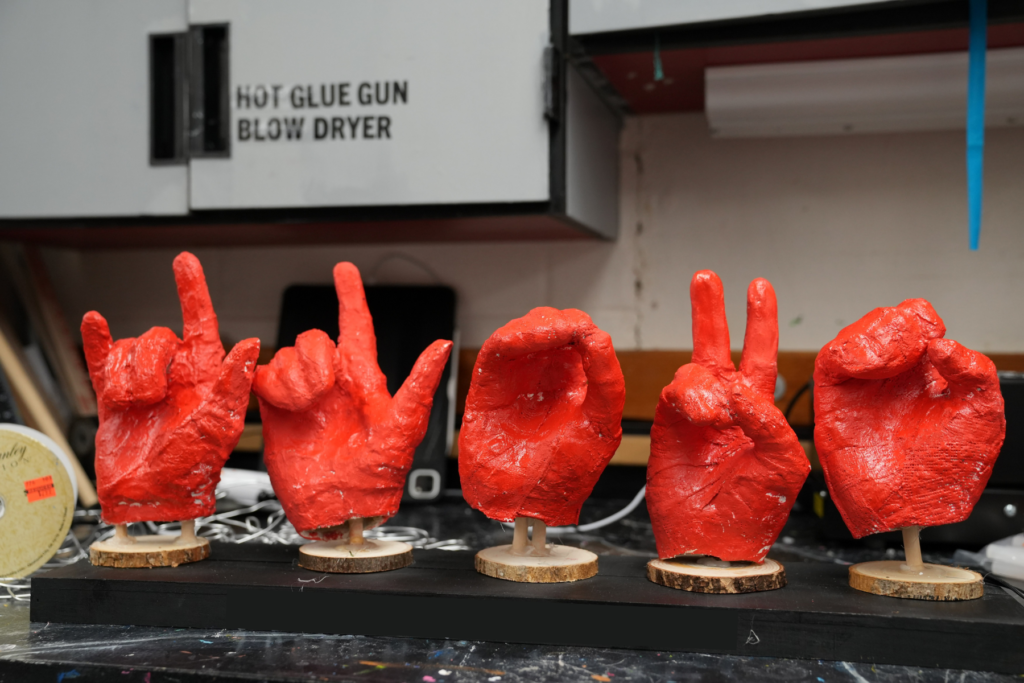A Review of the Brailliant BI 20X
The Brailliant BI 20X is a 20-cell braille display featuring a standard Perkins-style keyboard. Read a review about this new device here.

By Scott Davert, Coordinator: Technology, Research and Innovation Center, Helen Keller National Center for DeafBlind Youths and Adults
June 3, 2021
Introduction
In April, I evaluated the Brailliant BI 40X from Humanware. In that evaluation I mentioned there was a 20-cell model as well. Unlike when I reviewed the Focus Blue Fifth Generation displays, which are the same display other than the amount of cells, the two models of Brailliants sport some differences. Physical differences aside, the software functions the same.
What’s in the box?
The box is divided into three layers. The top layer is where you will find the Brailliant BI 20X along with a print Getting Started guide. The second layer inside the box contains a USB-A to USB-C cable along with a wall charger. On the bottom layer you will find a case with a lanyard attached to it. Due to how this display was packed, it could be easy to miss the case since it is buried under two other layers.
The case
The case fits around the Brailliant BI 20X snugly and covers all keys, the braille display and cursor routing buttons. Like the BI 40X case, it closes with a magnet and does not cover the ports on the sides or front. Unlike the Brailliant BI 40X case, the one that comes with the 20-cell model is nylon. At that time I was using a similar product called the Chameleon 20, which ships with the same case, and I found that relatively short amounts of time spent in the sun melted a lot of the glue. Humanware did replace my case since this happened roughly three months after purchase, but it may be worth noting. There is a case which can be purchased from Executive Products or through Humanware for $89.95 which works very well with the Brailliant. It has anti-slip material on the back, contains a pocket for storing things like SD cards and appears to stand up well in sunny and warm environments.
Description
The Brailliant BI 20X is a 20-cell braille display featuring a standard Perkins-style keyboard, 16 gigabytes of internal memory and the ability to connect to external media through the USB-A port and SD card reader. It measures 7.2 inches long by 3.3 inches wide by 0.8 inches thick and weighs 0.88 pounds.
Orientation of Brailliant BI 20X
Positioning the device so the spacebars are closest to you, the lay-out is as follows. On the front edge from left to right, just like its larger counterpart, are five buttons. First is the Previous Thumb Key followed by the Left Thumb Key which is about twice as long as the Previous Thumb Key. In the middle is a circular shaped button known as the Home Key. This Key is always used to return you to the previous menu. To the right of the Home Key is the Right Key followed by the Next Key. The Right Thumb Key is larger than the Next Key. The two larger Thumb Keys on the front of the device are what pans the display back and forth.
The Previous and Next Thumb Keys are used for navigational purposes that depend on the application in use and how they are configured.
On the left side you will find three items. Moving from front to back, you will find a USB-A port used for inserting a thumb drive. Behind this is the Power button. Pressing and holding it for several seconds will toggle the power and a quick press when the device is on will either wake it up or put it to sleep. Behind this is a USBC port for charging or connecting it to a computer. On the right side are a mono speaker, two volume buttons and a 3.5MM headphone jack which were not operational at the time of this evaluation.
On the top surface, the keys located closest to you are two spacebars. Behind these, you will find the 20 braille cells with a corresponding Cursor Routing Key behind each cell. Behind the Cursor Routing Keys is a standard eight-dot Perkins-style braille keyboard. Along the back side of the Brailliant BI 20X, you will find an SD card reader. The under-side of the display has a braille serial number and a couple of rubber feet to hold it in place. There is also a removable battery secured by two screws.
Other differences between the Brailliant BI 20X and BI 40X
The differences between the 20- and 40-cell models are that the 20 lacks C keys, stereo speakers and a microphone. The 40-cell model does not have an SD card reader but does have twice the amount of internal memory. The 40-cell model does not have a removable battery like the 20 does. The Brailliant BI 40X is using Bluetooth 5 which also supports 2.4ghz and 5ghz Wi-Fi. The Brailliant BIi 20x has Bluetooth 4.2 and only supports 2.4ghz Wi-Fi.
New update for both models
Not long after the Brailliant BI 40X review was published, Humanware released an update to the firmware of both devices. New features include plain text support for PDF files, a shortcut key to create a new note from within any part of the operating system other than Terminal, the option of switching braille tables on-the-fly, an increased amount of time on Exam Mode and a few other enhancements listed in the above linked document.
New documentation
The Humanware support page has been updated to include how to use the display with VoiceOver for iOS and JAWS for Windows. These instructions contain unlabeled images that I presume are screenshots along with typos, but the information is available. It is my hope that these instructions can be incorporated into a future release of the User Guide so that all of the information can be found in one place.
The updating process
The User Guide has been updated to reflect firmware version 1.1.1. The User Guide provides helpful information on the various ways that a user can update their Brailliant BI 20X or Brailliant BI 40X. However, when updating manually through the online method, version 1.1 requires you to go to the options menu, select about and then choose to check for update. Once updated to 1.1.1, there will be a new option in the Options menu called “Software Update.” I have upgraded three devices so far and all of them have updated successfully. The only thing to be aware of when updating is that once complete, the device will shut off and not restart. You will need to press and hold the power button to restart it and then verify you are running the latest version by pressing space with the letter I.
PDF support
While PDF documents can now be read on the new Brailliant displays, that functionality does come with a couple of limitations. One of them is that any kind of formatting available such as headings in the document is not preserved in version 1.1.1 of the firmware. It is not known if support of structured PDF files will come to these displays or not. The other limitation is that it does take quite some time to open PDF documents. The timing on the 20- and 40-cell models appears to be about equal. A 1.4 MB file took about 40 seconds to open. However, the fact that PDF files can be viewed on these devices is a welcomed addition.
New keyboard shortcuts
One of the things many people might wish to do with a braille display is quickly create a note. Prior to version 1.1.1, users had to go to the Editor, then go to open and press enter. It’s now possible to press Backspace with n to start a new note in the Editor. This works from anywhere within the Brailliant unless the user is in the Terminal program. I found this feature handy, as I often wish to document small pieces of information that need to be written separate of other files. This new shortcut saves several steps in this process.
There is also a command for toggling among available braille tables. This is accomplished with the keyboard command Dots 1-2-4-5 -7, or backspace with the letter g. Toggling between tables takes less than a second and is a handy way to quickly view files in different formats. Note that if you are on eight-dot computer braille, you will also need to add the Spacebar to this command.
Comparing overall performance
As noted above, the Brailliant BI 20X and BI 40X run the same firmware, meaning they have the same feature set. Battery life, file load time, connecting over USB, the downloading of content and almost every other function appears to perform equally. One of the few differences is in the Bluetooth connection between the Brailliant and a screen reader. I found that the connectivity on the 40X was slightly more reliable than the 20X, particularly with regard to the range of the signal. The 20X only seems to be fully reliable from around 20 feet away. The Brailliant BI 40X seems to be able to handle the connection for up to 30 feet. This is most likely on account of the 20X running Bluetooth version 4.2 while the 40X runs Bluetooth version 5.
Conclusion
It is encouraging to see Humanware continue to innovate, issuing new firmware updates and ultimately making these devices more capable. Individuals on the go will likely find the 20-cell Brailliant to be an excellent fit. It is portable and offers respectable battery life while providing mostly the same feature set as its larger counterpart. I find the full sized SD card reader to be a welcomed feature as unlike with a thumb drive, the SD card can remain in the unit and will not stick out, risking damage to the drive or the USB port. Beyond these points, my conclusions are the same as they were in my review of the Brailliant BI 40X.
Product information
The Brailliant BI 20X is available for purchase through Humanware and costs $2199.00. (UPDATE 1/24/23: I have updated the price in the previous sentence to reflect the price change, as the Brailliant BI 20X was $1895.00 at the time of writing this article.)


